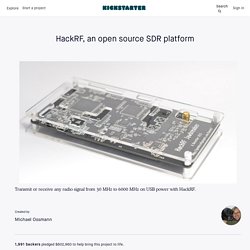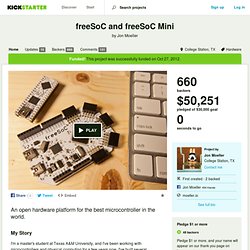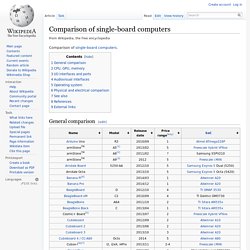

Spark - Particle. LPC ARM boards. ESP8266 WiFi IoT. Linux Embedded Devices Comparison: Yun, BeagleBoard, Rascal, Raspi, Cubieboard & pcDuino. Awaiting for the new release, Arduino Yun, I think it's very interesting to know more about the new linux devices in the market.

There are a lot of emerging ones and many of them agree in the same feature: to be Arduino-compatible. Why? Arduino was launched in 2005 and it has become in a standard as a modular platform, so all new devices want to add this feature, allowing people to use each platform as easy as Arduino. Some can carry Ethernet, Wifi, HDMI, NAND flash... these features change in each board we are going to compare. But all of them have GPIOs, and even an expansion board to make the port easy.
xCORE. Mbed OS. Open WART. Teensy. Electric Imp. ByPic. Radxa. UDOO Quad. HackRF, an open source SDR platform by Michael Ossmann. Risks and challenges Because the beta design has already been tested by many people, it is very unlikely at this point that any technical design challenges will prevent the HackRF project from being a success.

I routinely use a contract manufacturer to produce electronic devices I distribute to resellers, but projects can be delayed for a variety of reasons. The most significant delay I have ever experienced was the HackRF Jawbreaker beta production. I had hoped that the production would be completed in two to three months, but it took a total of seven months. The largest source of delay during Jawbreaker production was component availability. I hope that it gives you confidence to know that I already have delivered 500 HackRF beta units and that I successfully delivered Ubertooth One on time to the backers of my first Kickstarter project. Learn about accountability on Kickstarter. FreeSoC and freeSoC Mini by Jon Moeller. I'm a master's student at Texas A&M University, and I've been working with microcontrollers and physical computing for a few years now.

I've built several interesting projects, many of which you can find on my portfolio, including one you may have seen on TV. Like many of you, I got started with an Arduino, but I found myself limited by the inflexibility of the platform: too little bandwidth over the UART, too few analog inputs, too few digital outputs, etc. That's why I decided to create the freeSoC, an open hardware platform for the best microcontroller in the world: Cypress Semiconductor's PSoC 5. I hope this project will enable makers around the world to explore the world of possibilities enabled by the PSoC microcontroller. Never let your tools get in the way of your imagination again. We're kickstarting this project to raise funds for the first big production run of these boards. An overview and comparison of today’s single-board micro computers. As we have concluded earlier, there are quite a few single-board micro computers out there today to choose from.

Some of them offer better performance and more memory than others, some of them have a great variety of connectors while others only have the necessary minimum. A part of these devices can connect to custom hardware through general purpose input-output pins, while others are more integrated and less customizable. Most of them are based on the ARM architecture, which restricts their use to operating systems like Linux, Android, etc, but a few surprise us with an x86 design and can even run Windows.
Although they are generally small, there still are significant differences between them in size. Some of them target home users while others are built for hackers and computer experts. Raspberry Pi. Comparison of single-board computers. From Wikipedia, the free encyclopedia Comparison of single-board computers.

General comparison[edit] Notes ^Price range : approximate price as of August 2014, grouped in these intervals: Lowest cost, corresponding to 0-49 USD;Low cost, corresponding to 50-79 USD;Medium cost, corresponding to 80-119 USD;High cost, corresponding to 120-169 USD;Highest cost, corresponding to 170 USD and higher. CPU, GPU, memory[edit] I/O interfaces and ports[edit] Notes ^Utilite mSATA : the mSATA slot in Utilite is considered non-user-serviceable and the procedure to access it causes the warranty to be void.[60][61]
Carambola. 39 low-cost boards for embedded Linux application development starting with Raspberry Pi. Want the list? 39 low-cost boards for embedded Linux application development starting with Raspberry Pi.

Want the list? Thanks to Google+, I just found this very interesting list of 39 low-cost development boards supporting embedded Linux development. Most of these boards cost less than US $200 and many of them cost less than US $100. The list was published on CNX Software’s Web site, which supplies more details on each board such as the price. Here’s the product list, including the processors used on the boards: Raspberry Pi Model B – Broadcom BCM2835 (ARM11)Rikomagic MK802 – Allwiner A10 (ARM Cortex-A8)Mele A1000 – AllWinner A10 (ARM Cortex-A8)Rhombus-Tech A10 EOMA-68 – AllWinner A10 (ARM Cortex-A8)Gooseberry board – AllWinner A10 (ARM Cortex-A8)A13-OLinuXino – AllWinner A13 (ARM Cortex-A8)VIA APC – Wondermedia WM8650 (ARM11)VIA ARTiGO A1200 – VIA Eden X2 (x86)VIA ARTiGO A1150 – VIA Eden X2 (x86)BeagleBoard Rev.
The reason for pointing these boards out is because they are the symptom of a trend.
Launchpad TI. Cubierbord. ARM boards. ODROID U2. Gecko boards. APC. Flyport. SBC_comparison44. BeagleBone. Raspberry Pi.